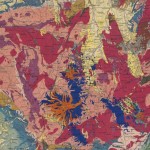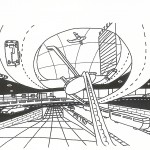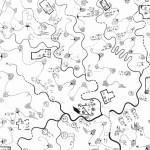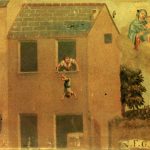Hans Richter (April 6, 1888 – February 1, 1976), a German avant garde artist who had contacts with “Der Blaue Reiter“, Cubism and Dada movements, was an early experimenter in abstract filming. Deeply involved in political militancy, he opposed war and supported the revolution. He co-founded in 1919, the Association of Revolutionary Artists (“Artistes Radicaux”) at Zürich.
Although not quite the first abstract film (as Richter claimed), his Rhythmus 21 (1921) was nevertheless an important historical experiment and the first development of a research he and Eggling began in 1918 with scroll paintings (in a dada rejection of traditional easel painting). After they took their drawings to the German Film production company U.F.A. the two artists received technical advice and in 1920 began using video cameras.
The language of Rhytmus 21 is characterized by simple shapes in motion. As explained by the author in 1927:
“It is not the natural movement of film that gives the objects their expression, but the artistic movement, that is to say, a rhythmical movement regulated by itself in which variations and pulsations form a part of the artistic design.”
-Hans Richter, “Mouvement”, (1927)
From 1923 to 1926, Richter edited, together with Werner Gräff and Mies van der Rohe, the periodical G. Material zur elementaren Gestaltung. Richter wrote of his own attitude toward film:
“I conceive of the film as a modern art form particularly interesting to the sense of sight. Painting has its own peculiar problems and specific sensations, and so has the film. But there are also problems in which the dividing line is obliterated, or where the two infringe upon each other. More especially, the cinema can fulfill certain promises made by the ancient arts, in the realization of which painting and film become close neighbors and work together.”
After his moving from Switzerland to the USA in 1940 Richter continued his work on avantgarde film, began teaching in the Institute of Film Techniques at the City College of New York and returned to painting since 1958.




“In Rhythmus ’21, generally considered to be the first completely abstract film, Richter used these principles to create a work of remarkable structural cohesion. Completed by using stop motion and forward and backward printing in addition to an animation table, the film consists of a continuous flow of rectangular and square shapes that “move” forward, backward, vertically, and horizontally across the screen. Syncopated by an uneven rhythm, forms grow, break apart and are fused together in a variety of configurations for just over three minutes (at silent speed). The constantly shifting forms render the spatial situation of the film ambivalent, an idea that is reinforced when Richter reverses the figure-background relationship by switching, on two occasions, from positive to negative film.
In so doing, Richter draws attention to the flat rectangular surface of the screen, destroying the perspectival spatial illusion assumed to be integral to film’s photographic base, and emphasizing instead the kinetic play of contrasts of position, proportion and light distribution. By restricting himself to the use of square shapes and thus simplifying his compositions, Richter was able to concentrate on the arrangement of the essential elements of cinema: movement, time and light. Disavowing the beauty of “form” for its own sake, Rhythmus ’21 instead expresses emotional content through the mutual interaction of forms moving in contrast and relation to one another. Nowhere is this more evident than in the final “crescendo” of the film, in which all of the disparate shapes of the film briefly coalesce into a Mondrian-like spatial grid before decomposing into a field of pure light.
According to Richter, the original version of Rhythmus ’21 was never shown publicly in Berlin. At the behest of Theo van Doesberg, however, it was shown in Paris in 1921, with Richter introduced as a Dane due to anti-German sentiment. In May 1922, Richter travelled with van Doesberg and El Lissitzky to the First International Congress of Progressive Artists, where they formed the International Faction of Constructivism. In a group manifesto, written by Richter, they define the progressive artist ‘as one who denies and fights the predominance of subjectivity in art and does not create his work on the basis of random chance, but rather on the new principles of artistic creation by systematically organizing the media to a generally understandable expression’.”
– (Richard Suchenski, Hans Richter, read full text here : sensesofcinema.com/2009/great-directors/hans-richter/)




Via: Rudy/Godinez
Images via Rudy/Godinez and Newrafael, Video via: Avant garde cinema





Leave a Reply